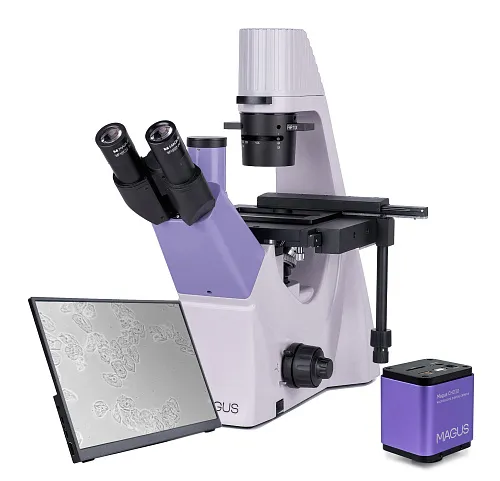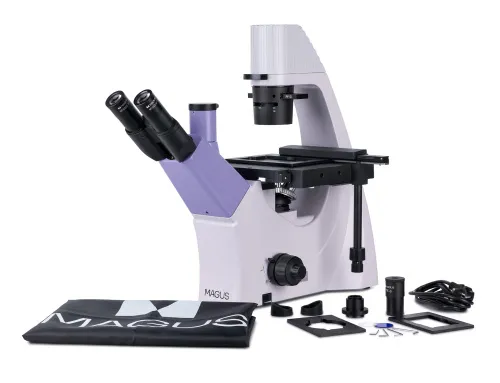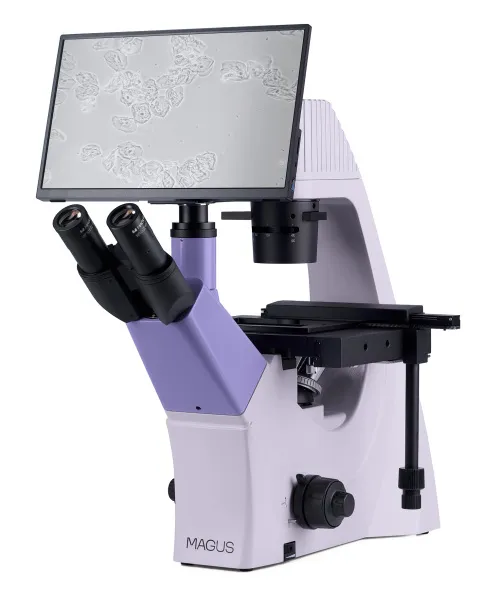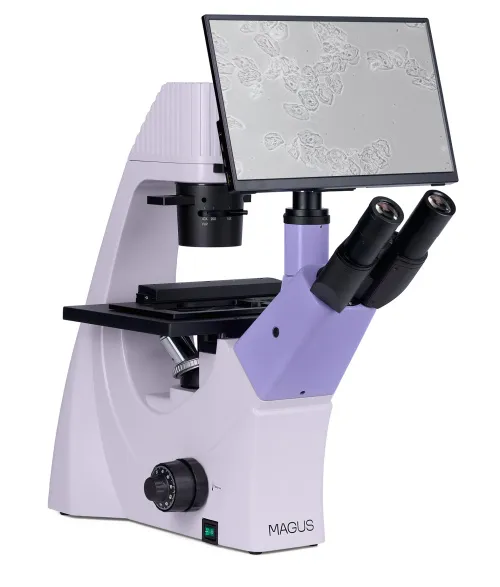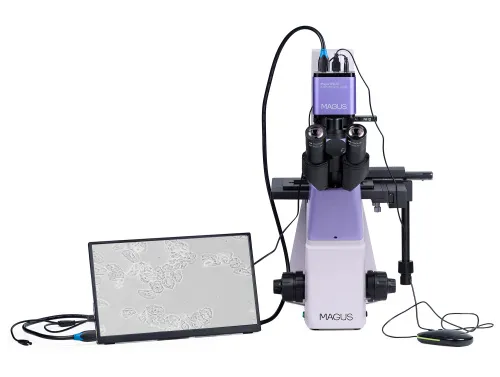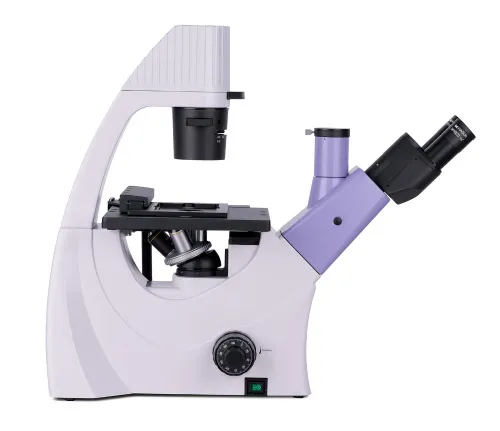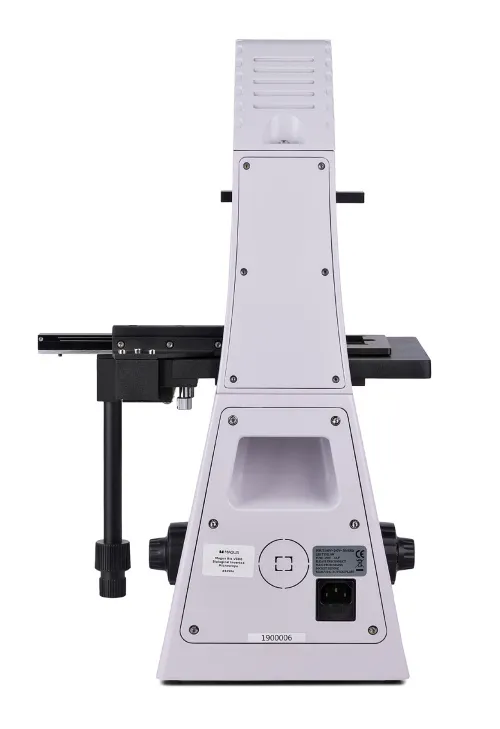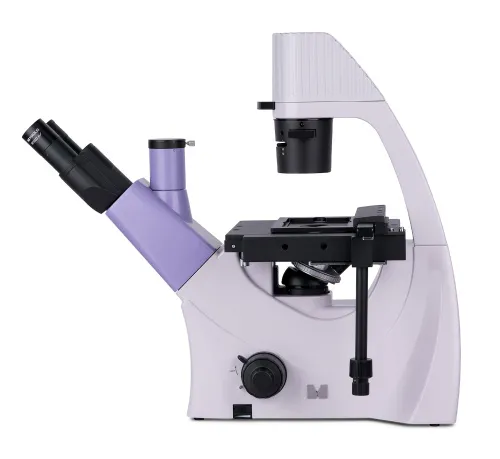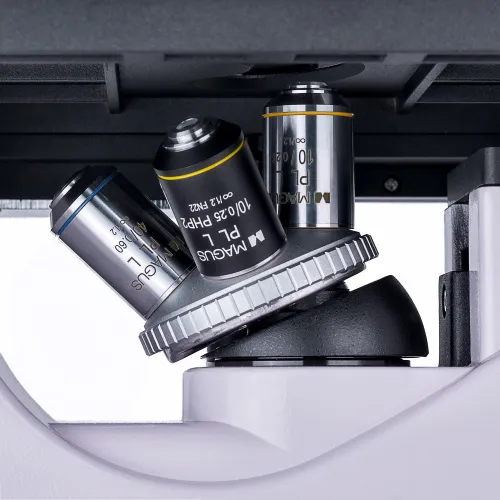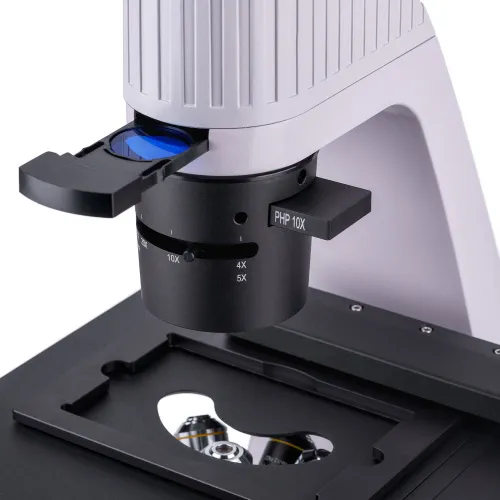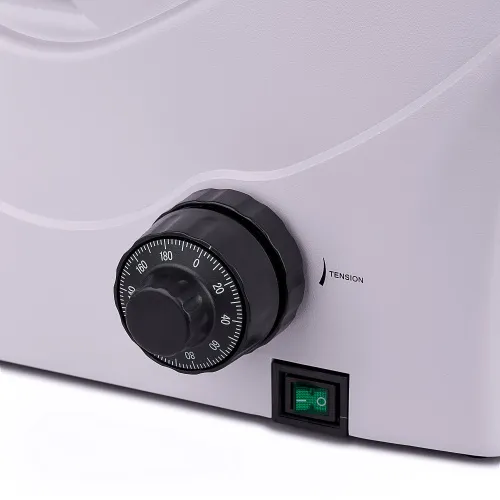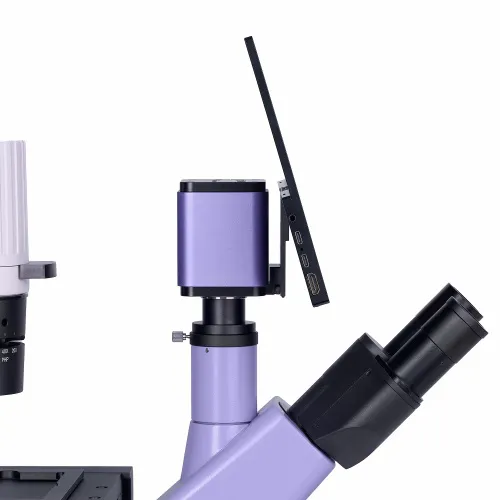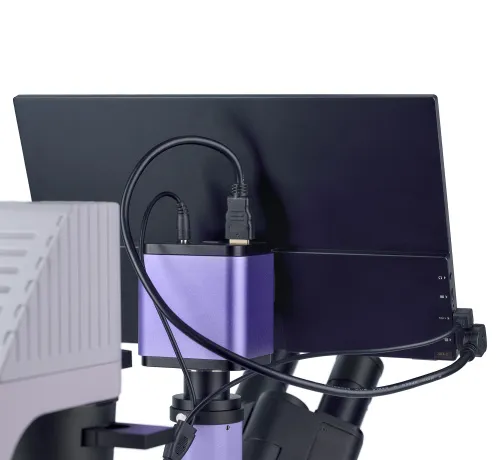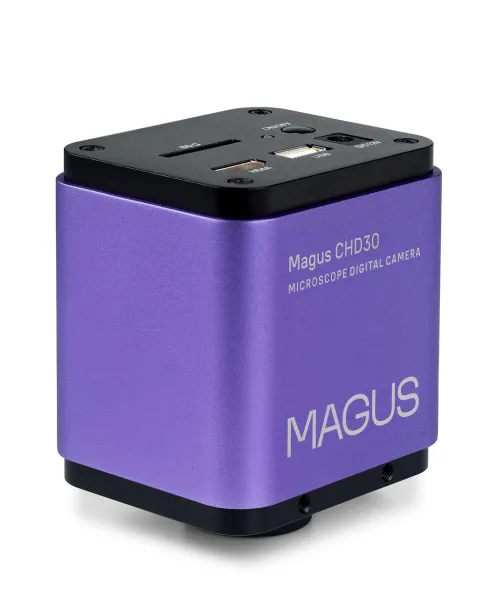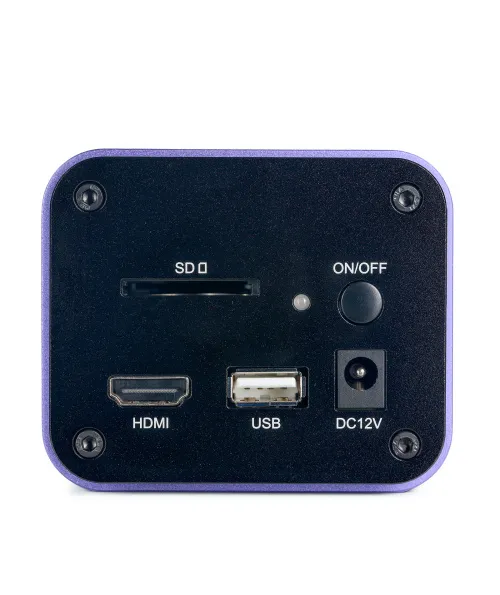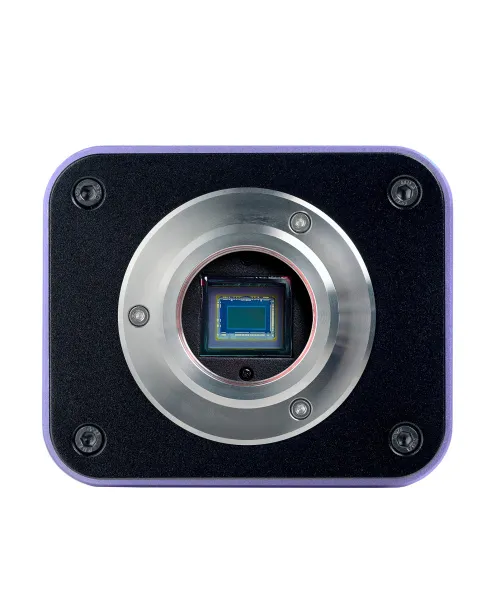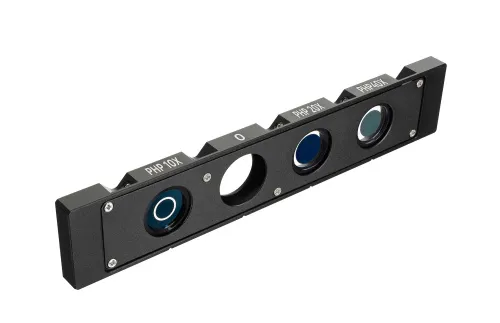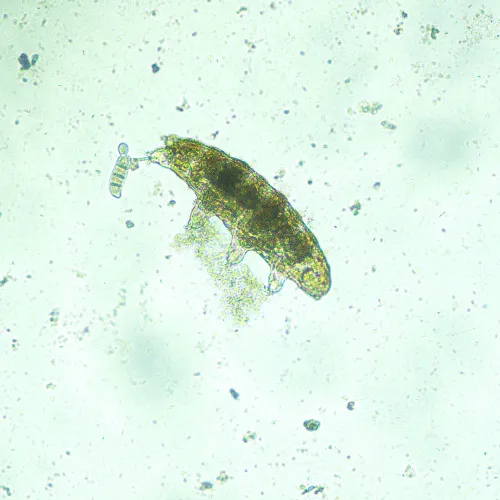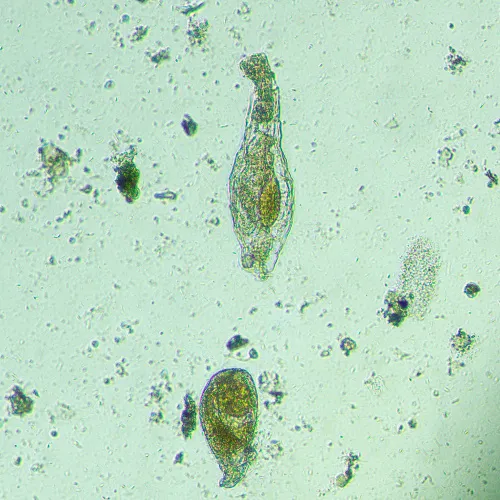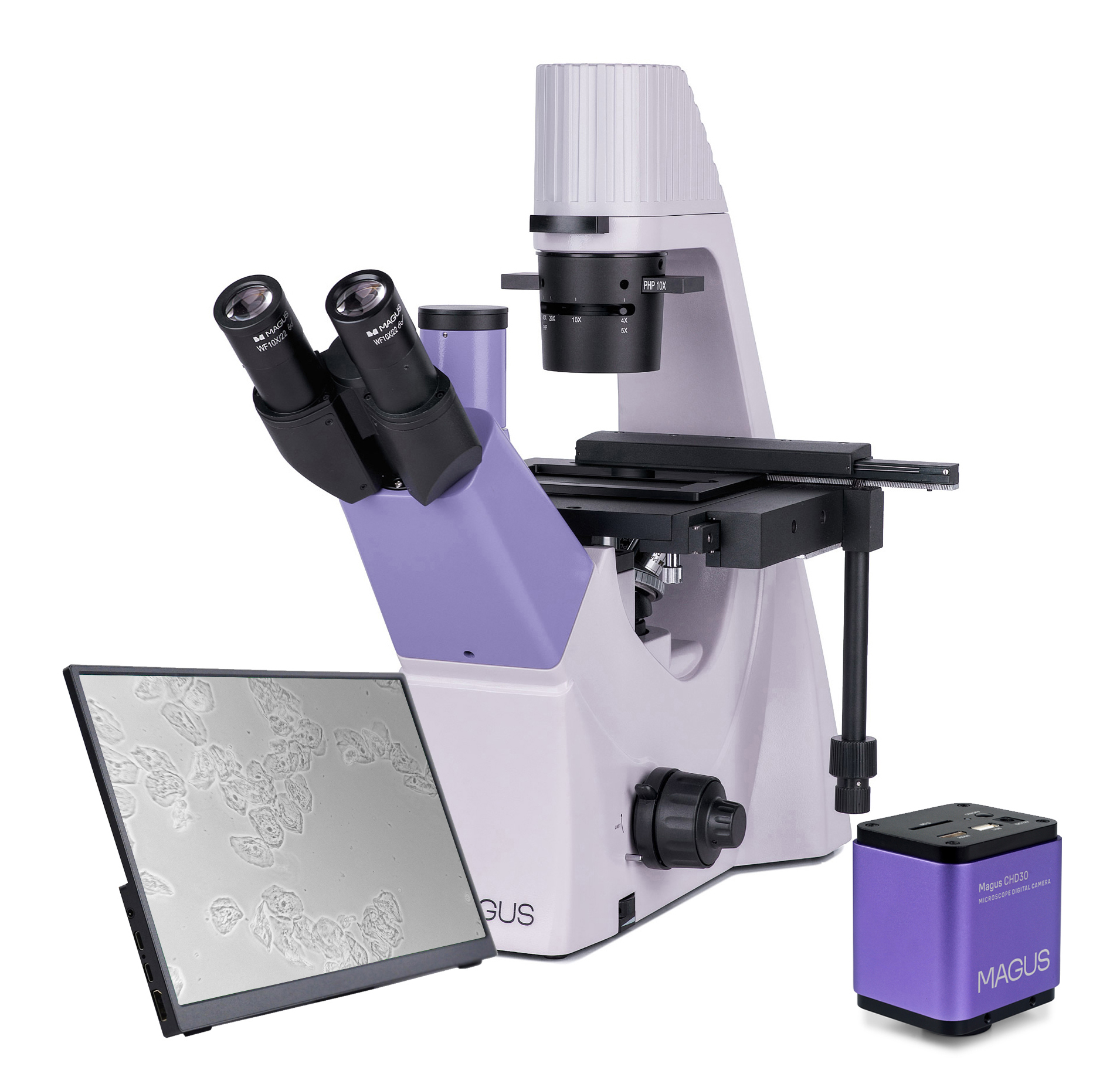MAGUS Bio VD300 LCD Biological Inverted Digital Microscope
With a camera and monitor. Magnification: 100–400x. Trinocular head, infinity plan achromatic objectives, 9W LED illuminator, condenser with a phase slider slot
| Product ID | 83013 |
| Brand | MAGUS |
| Warranty | 5 years |
| EAN | 5905555018102 |
| Package size (LxWxH) | 64x42x67 cm |
| Shipping Weight | 20.75 kg |
MAGUS Bio VD300 LCD is a biological microscope of an inverted design for studying samples in laboratory ware up to 70 mm high and with a bottom thickness up to 1.2 mm. The objects of study can be colonies of cells, tissue cultures, biological fluids, etc. The samples do not require mandatory pre-staining. The observations are made in transmitted light. Microscopy techniques: brightfield and phase contrast. The microscope is suitable for routine and research work, and teaching.
Digital camera
The MAGUS CHD30 digital camera is equipped with a 2MP sensor and produces realistic Full HD images at a resolution of 1920x1080px. The camera features high light sensitivity, auto focus function, and it is suitable for fluorescent observations. The camera uses an HDMI interface to connect directly to a TV, monitor, or projector. In this mode, the camera operates autonomously without a connection to a PC. The HDMI interface provides a high and stable transfer rate from the camera to the external screen. You can connect it to a PC via Wi-Fi. Video is recorded at 60fps or 25fps depending on the video output interface. The camera combines high FPS and high bandwidth HDMI. Therefore, videos are vivid with no freezes or gaps between frames. At maximum resolution, the image is well-detailed, moving objects are visible without bugs, and object movement is displayed without delays.
Monitor
MAGUS MCD monitors work in combination with MAGUS CHD cameras to form a complete imaging system for MAGUS microscopes.
The connection to the camera occurs via its HDMI interface. The monitor displays real-time images. Its IPS LCD display has a wide viewing angle, high brightness, and good contrast. When looking at the screen even from a large angle, the image is not distorted. The screen size is 13.3''.
The monitor can be installed on a horizontal surface using a folding stand or mounted directly on a camera or tripod.
Optics
The microscope is equipped with a classic trinocular head, the trinocular tube is used for mounting a digital camera. The camera is not included in the set. The beam splitting is 50/50. Four included or additional objectives can be mounted in the revolving nosepiece. All objectives are designed to be used with laboratory ware and have a long working distance. There are 3 plan achromatic objectives for brightfield and 1 plan achromatic objective for the phase contrast technique.
Illumination
The transmitted light source is a 9W LED. The high power of the LED makes the illumination of the working area bright enough to work with all objectives and with any microscopy technique. The brightness adjustment does not change the color temperature. The LED lifetime is about 50,000 hours without LED replacement. The condenser has a slot for a phase contrast slider (included). The phase contrast rings can be centered. The installation of the slider saves time when switching between the microscopy techniques.
Stage and focusing mechanism
Fixed mechanical stage. It is equipped with a dish holder (three dish holders of different sizes are included). The dishes can be moved along the X and Y axes by a mechanical attachment. The coaxial coarse and fine focusing mechanism provides accurate and fast focusing. The coarse focusing has a lock mechanism and tension adjustment.
Accessories
The optional accessories line includes phase objectives, eyepieces, digital cameras, and calibration slides.
Key features of the microscope:
- Brightfield and phase contrast microscopy techniques in the transmitted light; studying samples in laboratory ware
- Digital camera is mounted in the trinocular tube
- 9W LED transmitted light illuminator with adjustable brightness and a long lifetime
- Fixed stage with two-axis movement, 3 dish holders for different sizes included
- Optional accessories to improve microscope performance
Key features of the camera:
- The camera operates autonomously without a connection to a PC via the HDMI interface. It can be connected to a PC via USB2.0 interface
- The auto focus in HDMI mode makes it easier to adjust image sharpness
- The camera resolution is 1920x1080px – an ideal choice for displaying images on a Full HD monitor
- 60fps for observing moving objects, recording video and moving the preparation without jerkiness or delays
- 25fps via Wi-Fi – enough for focus adjustment and image processing using the software
- SONY color CMOS sensor – low noise level and high light sensitivity
- Software with photo, video recording, editing, external display functions, linear and angular measurements
The kit includes:
- MAGUS CHD30 Digital Camera (digital camera, HDMI cable (1.5m), USB mouse, 32GB SD memory card, USB Wi-Fi adapter, AC power adapter 12V/1A (Euro), installation CD with drivers and software, user manual and warranty card)
- MAGUS MCD20 LCD Monitor
- Stand with the built-in power supply, transmitted light source, focusing mechanism, stage, condenser with a slot for phase-contrast slider, and revolving nosepiece
- Trinocular head
- Infinity plan achromatic objective: PL 10x/0.25 WD 4.27mm
- Infinity plan achromatic objective: PL L20х/0.40 WD 8.0mm
- Infinity plan achromatic objective: PL L40х/0.60 WD: 3.5mm
- Infinity plan achromatic objective: PHP2 10x/0.25 phase WD 4.27mm
- Eyepiece 10x/22mm with long eye relief (2 pcs.)
- Eyecup (2 pcs.)
- Centering telescope
- Phase contrast slider with centering phase rings
- Mechanical attachment for moving the specimen
- Dish holder (3 pcs.)
- C-mount camera adapter
- Color filter
- AC power cord
- Dust cover
- User manual and warranty card
Available on request:
- 10x/22mm eyepiece with a scale
- 12.5x/14mm eyepiece (2 pcs.)
- 15x/15mm eyepiece (2 pcs.)
- 20x/12mm eyepiece (2 pcs.)
- 25x/9mm eyepiece (2 pcs.)
- Infinity plan achromatic objective: PL 4x/0.10 WD 21mm
- Infinity plan achromatic objective: PHP2 20x/0.40 phase WD 8.0mm
- Infinity plan achromatic objective: PHP2 40x/0.60 phase WD 3.5mm
- Calibration slide
| Product ID | 83013 |
| Brand | MAGUS |
| Warranty | 5 years |
| EAN | 5905555018102 |
| Package size (LxWxH) | 64x42x67 cm |
| Shipping Weight | 20.75 kg |
| Type | biological, light/optical, digital |
| Microscope head type | trinocular, digital screen/PC monitor |
| Head | Siedentopf |
| Head inclination angle | 45 ° |
| Magnification, x | 100 — 400 |
| Magnification, x (optional) | 40–500/600/800/1000 |
| Eyepiece tube diameter, mm | 30 |
| Eyepieces | 10х/22mm, eye relief: 10mm (*optional: 10x/22mm with scale, 12.5x/14; 15x/15; 20x/12; 25x/9) |
| Objectives | infinity plan achromatic: PL 10x/0.25, PL 20x/0.40, PL 40x/0.60, PHP2 10x/0.25 phase; parfocal distance 45mm (*optional: PL 4x/0.10, PHP2 20x/0.40 phase, PHP2 40x/0.60 phase) |
| Revolving nosepiece | for 4 objectives |
| Working distance, mm | 4.27 (10x); 8.0 (20х); 3.5 (40x) |
| Interpupillary distance, mm | 48 — 75 |
| Stage moving range, mm | 77/112 |
| Stage features | fixed, with mechanical attachment for moving the specimen; dish holders: 29x77mm, Ø90mm; 34x77.5mm, Ø68.5mm; 57x82mm, Ø60mm |
| Condenser | NA 0.6, working distance: 70mm; with adjustable aperture diaphragm and a phase contrast slider slot |
| Diaphragm | adjustable aperture |
| Focus | coaxial, coarse (with coarse focusing tension adjustment and a lock knob), and fine (0.002mm) |
| Illumination | LED |
| Brightness adjustment | ✓ |
| Power supply | 220±22V, 50Hz, AC network |
| Light source type | 9W |
| Light filters | yes |
| Operating temperature range, °C | 5...+35 |
| Special features | phase contrast slider for a 10x objective with a centerable phase ring |
| User level | experienced users, professionals |
| Assembly and installation difficulty level | complicated |
| Application | laboratory/medical |
| Illumination location | upper (transmitted light) |
| Research method | bright field, phase-contrast microscopy |
| Pouch/case/bag in set | dust cover |
| Camera specifications | |
| Sensor | SONY CMOS |
| Color/monochrome | color |
| Megapixels | 2 |
| Maximum resolution, pix | 1920x1080 |
| Sensor size | 1/1.9" (7.20x4.05mm) |
| Pixel size, μm | 3.75x3.75 |
| Auto focus | ✓ |
| Interface connectors | HDMI 1.4, Wi-Fi |
| Memory card | SD up to 32GB |
| Ability to connect additional equipment | USB mouse, Wi-Fi adapter (USB) |
| Wi-Fi settings | 802.11n, 150Mbps, 20dBm |
| Light sensitivity | 1120mV with 1/30s |
| Signal/noise ratio | 0.15mV at 1/30s |
| Exposure time | 0.06ms–918ms |
| Video recording | ✓ |
| Frame rate, fps at resolution | 25@1920x1080 (Wi-Fi), 60@1920x1080 (HDMI) |
| Place of installation | trinocular tube, eyepiece tube instead of an eyepiece |
| Image format | *.jpg |
| Video format | *.asf |
| Spectral range, nm | 380–650 (built-in IR filter) |
| Shutter type | ERS (electronic rolling shutter) |
| Software | HDMI: built-in; USB: MAGUS View |
| System requirements | Windows 8/10/11 (32bit and 64bit), Mac OS X, Linux, up to 2.8GHz Intel Core 2 or higher, minimum 4GB RAM, USB2.0 port, RJ45, 19" or larger display |
| Mount type | C-mount |
| Body | CNC aluminum alloy |
| Camera power supply | DC adapter 12V, 1A |
| Camera operating temperature range, °С | -10...+50 |
| Operating humidity range, % | 30 — 80 |
| Monitor specifications | |
| Type of matrix | IPS |
| Display diagonal, inch | 13.3 |
| Display resolution, px | 1920x1080 (Full HD) |
| Aspect ratio | 16:9 |
| Brightness, cd/m² | 400 |
| Number of displayed colors | 16.7 m |
| Contrast | 1000:1 |
| Horizontal/vertical viewing angle, ° | 178/178 |
| Size of the visible screen area (WxH), mm | 295x165 |
| Pixel pitch (WxH), mm | 0.154x0.154 |
| Frequency of optical source, Hz | 60 |
| Type of matrix backlight | LED |
| LED backlight lifetime, h | 50000 |
| Interface | HDMI |
| Operating temperature range, °C | -15...+55 |
| Operating humidity range, % | 10 — 90 |
| Power supply | AC 110–220V, DC 5–12V/1A (Type-C) |
| Power consumption, W | 12 (max.) |
and downloads
We have gathered answers to the most frequently asked questions to help you sort things out
Find out why studying eyes under a microscope is entertaining; how insects’ and arachnids’ eyes differ and what the best way is to observe such an interesting specimen
Read this review to learn how to observe human hair, what different hair looks like under a microscope and what magnification is required for observations
Learn what a numerical aperture is and how to choose a suitable objective lens for your microscope here
Learn what a spider looks like under microscope, when the best time is to take photos of it, how to study it properly at magnification and more interesting facts about observing insects and arachnids
This review for beginner explorers of the micro world introduces you to the optical, illuminating and mechanical parts of a microscope and their functions
Short article about Paramecium caudatum - a microorganism that is interesting to observe through any microscope

